Roma antica foro romano colosseo altare della patria circo massimo roma virtuale 3d lazio
piazze-eng
inglese
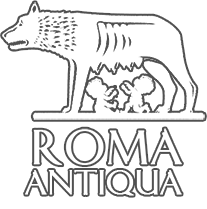


Squares
Navona Square (Piazza Navona)
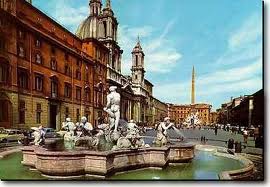 History of Piazza Navona dates back to the times of ancient Rome. It is built on the site of the Stadium of Domitian, built in I century AD, once dedicated to public entertainment, games, and simulation of naval battles Piazza Navona has remained a place of amusement even after its decay. It was a place where people used to gathered for events and festivity. This tradition run until nineteenth century when comedians,acrobats, and fools used to entertain people on holidays.Its actual shape dates back to 1600-1700 and the fountains, Pamphili Palace, (today site of Brazil Embassy), and Saint Agnese church were already there. Since then it has retained its shape. This is one of the reasons that makes it so amazing. The obelisk in the center of the square is about 16 metres high. It is placed on a stand made of The Fountain of Rivers, by Gianlorenzo Bernini, representing the four major rivers the Nile, the Danube, the Ganges and the Rio de la Plata. The Church of Saint Agnes in Agone, by Borromini, is dedicated to the homonymous saint who, the legends holds, died in the Circus of Domitian in the very point where the Church was erected.
History of Piazza Navona dates back to the times of ancient Rome. It is built on the site of the Stadium of Domitian, built in I century AD, once dedicated to public entertainment, games, and simulation of naval battles Piazza Navona has remained a place of amusement even after its decay. It was a place where people used to gathered for events and festivity. This tradition run until nineteenth century when comedians,acrobats, and fools used to entertain people on holidays.Its actual shape dates back to 1600-1700 and the fountains, Pamphili Palace, (today site of Brazil Embassy), and Saint Agnese church were already there. Since then it has retained its shape. This is one of the reasons that makes it so amazing. The obelisk in the center of the square is about 16 metres high. It is placed on a stand made of The Fountain of Rivers, by Gianlorenzo Bernini, representing the four major rivers the Nile, the Danube, the Ganges and the Rio de la Plata. The Church of Saint Agnes in Agone, by Borromini, is dedicated to the homonymous saint who, the legends holds, died in the Circus of Domitian in the very point where the Church was erected.
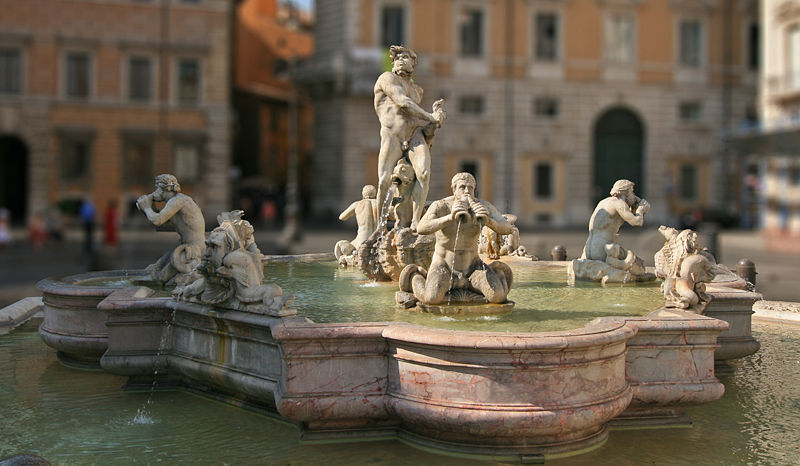 Fontana del Moro: the Moor Fountain (located at the southern of the Piazza Navona), commissioned by pope Gregory XIII Boncompagni, who increased the flow of water towards the place (taking it from the Aqueduct of Acqua Paola), by promoting in that way the introduction of plays of water in the fountains. The project was commissioned to Giacomo Della Porta in 1574, designer of the Fountain of Neptune at the other side of the place .He was helped by Bartolomeo Gritti and by a team of sculptors and stone-cutters, which made the decorations, dolphins, tritons, masks of faces and animals or shells, a repertoire coming from the classical times but in demand in that time. In 1653, pope Innocent X Pamphilj, redecorated it, commissioning it to Bernini. The sculpture in the middle which takes its name to the fountain, was designed by Bernini but carried out by Giannantonio Mari (1655), the statue should represent a muscular triton who subdues a dolphin, but it was mistaken for Moor for its somatic features. During the restoration of 1874 the 4 tritons and the four masks were replaced by copies by Luigi Amici, the original statues are situated in some municipal warehouse.
Fontana del Moro: the Moor Fountain (located at the southern of the Piazza Navona), commissioned by pope Gregory XIII Boncompagni, who increased the flow of water towards the place (taking it from the Aqueduct of Acqua Paola), by promoting in that way the introduction of plays of water in the fountains. The project was commissioned to Giacomo Della Porta in 1574, designer of the Fountain of Neptune at the other side of the place .He was helped by Bartolomeo Gritti and by a team of sculptors and stone-cutters, which made the decorations, dolphins, tritons, masks of faces and animals or shells, a repertoire coming from the classical times but in demand in that time. In 1653, pope Innocent X Pamphilj, redecorated it, commissioning it to Bernini. The sculpture in the middle which takes its name to the fountain, was designed by Bernini but carried out by Giannantonio Mari (1655), the statue should represent a muscular triton who subdues a dolphin, but it was mistaken for Moor for its somatic features. During the restoration of 1874 the 4 tritons and the four masks were replaced by copies by Luigi Amici, the original statues are situated in some municipal warehouse.
Spagna Square (Piazza di Spagna)
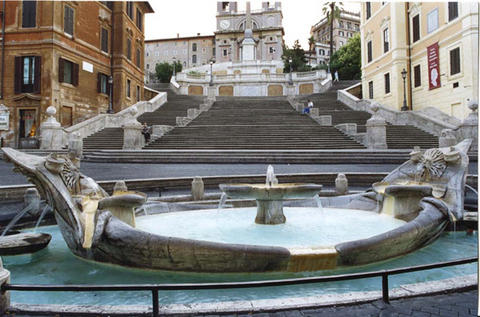 Piazza di Spagna is one of the most beautiful squares in Rome. The famous steps Trinità dei Monti is dominated by the facade of the homonymous Church built in the sixteenth century. Via Sistina, the road leading straight to The Basilica osfSanta Maria Maggiore, starts from here.The spectacle offered by the monumental stairway is one of the most fascinating in Rome. It was built over a project by Francesco De Sanctis, to honour the Cristian Trinity. Since ‘50s over Spring time,the stairs is embellished with thousands of azaleas that make Trinità dei Monti enchanting. The Barcaccia, the famous baroque fountain by Bernini is at the base of the stairs. It was built to commemorate the flood that struck Rome at the end of 1500’s.and the long boats used to carry merchandise from the Tiber river to the point where the fountain is. The square has long been considered as the cultural and tourist center of Rome, always crowded by artists.
Piazza di Spagna is one of the most beautiful squares in Rome. The famous steps Trinità dei Monti is dominated by the facade of the homonymous Church built in the sixteenth century. Via Sistina, the road leading straight to The Basilica osfSanta Maria Maggiore, starts from here.The spectacle offered by the monumental stairway is one of the most fascinating in Rome. It was built over a project by Francesco De Sanctis, to honour the Cristian Trinity. Since ‘50s over Spring time,the stairs is embellished with thousands of azaleas that make Trinità dei Monti enchanting. The Barcaccia, the famous baroque fountain by Bernini is at the base of the stairs. It was built to commemorate the flood that struck Rome at the end of 1500’s.and the long boats used to carry merchandise from the Tiber river to the point where the fountain is. The square has long been considered as the cultural and tourist center of Rome, always crowded by artists.
People's Square (Piazza del Popolo)
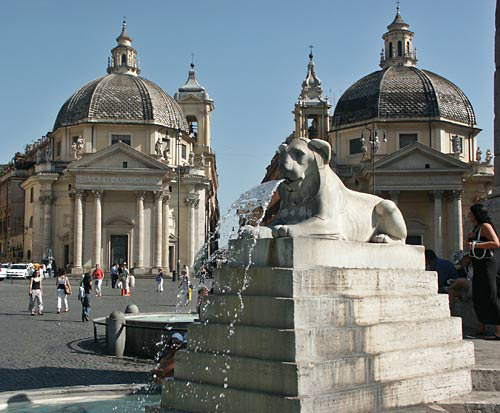 Piazza del Popolo is the starting point for three of the most famous streets of Rome: Via del Babuino,Via di Ripetta and via del Corso. It’s worth mentioning some of the characteristics of the place: Porta del Popolo was the first view for travellers coming from Via Flaminia upon arrival. The Porta dates back the IV century AC. Erected with the building of Aurelian Walls, it was inside decorated in 1600 on Piazza Bernini handside. The Egyptian Obelisk (1200BC) stands in the middle of the square whose three sides contain the churches of Santa Maria del Popolo, Santa Maria in Montesanto and Santa Maria dei Miracoli The first was built in the eleventh century but was modified until 1600 when Pope Alessandro II commissioned Bernini to restore the Church to make it more lively and baroque. It houses wonderful paintings by Caravaggio and Pinturicchio. The other two churches, called twin churches, ordered by Alessandro VII as well, gave the square the actual feature.
Piazza del Popolo is the starting point for three of the most famous streets of Rome: Via del Babuino,Via di Ripetta and via del Corso. It’s worth mentioning some of the characteristics of the place: Porta del Popolo was the first view for travellers coming from Via Flaminia upon arrival. The Porta dates back the IV century AC. Erected with the building of Aurelian Walls, it was inside decorated in 1600 on Piazza Bernini handside. The Egyptian Obelisk (1200BC) stands in the middle of the square whose three sides contain the churches of Santa Maria del Popolo, Santa Maria in Montesanto and Santa Maria dei Miracoli The first was built in the eleventh century but was modified until 1600 when Pope Alessandro II commissioned Bernini to restore the Church to make it more lively and baroque. It houses wonderful paintings by Caravaggio and Pinturicchio. The other two churches, called twin churches, ordered by Alessandro VII as well, gave the square the actual feature.
Fountain of Neptune: it was designed with the fountain of lions by the architect Giuseppe Valadier, it is situated in the middle of piazza del popolo, in order to improve the north side of the city. It was completed in 1823 and it has a great semicircular basin of travertine, in the upper part there is a great valve of shells, which collects the water poured from a little cup set on the top of it. The fountain is decorated with a great group of sculptures designed by Giuseppe Valadierma and carved by Giovanni Ceccarini, where the main element is a statue portraying Neptune with his trident, at its foot there are two statues of tritons leaned on the dolphins. Recently restored.
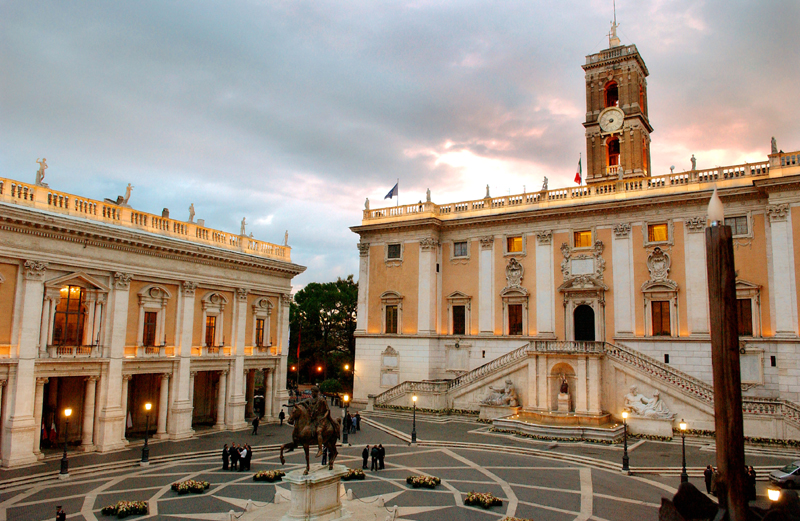 Capitol Square is the place of important buildings such as The Palace of Conservatori and Palazzo Nuovo on both sides and Palazzo Senatorio, seat of Municipality of Rome. The square was projected by Michelangelo in 1538.Access to the square runs trhough the Cordonata, also by Michelangelo, a great stairway bounded by the marble sculptures of Castore and Polluce. The paving shapes a twelve-pointed star with travertine, also projected by Michelangelo, but it was made only in the mid-1900’s. At the center of the square stands the Aequestrian Statue of Emperor Marcus Aurelius on a basement also created by Michelangelo. The statue was replaced with a copy and the originali s in the Capitoline Museum
Capitol Square is the place of important buildings such as The Palace of Conservatori and Palazzo Nuovo on both sides and Palazzo Senatorio, seat of Municipality of Rome. The square was projected by Michelangelo in 1538.Access to the square runs trhough the Cordonata, also by Michelangelo, a great stairway bounded by the marble sculptures of Castore and Polluce. The paving shapes a twelve-pointed star with travertine, also projected by Michelangelo, but it was made only in the mid-1900’s. At the center of the square stands the Aequestrian Statue of Emperor Marcus Aurelius on a basement also created by Michelangelo. The statue was replaced with a copy and the originali s in the Capitoline Museum
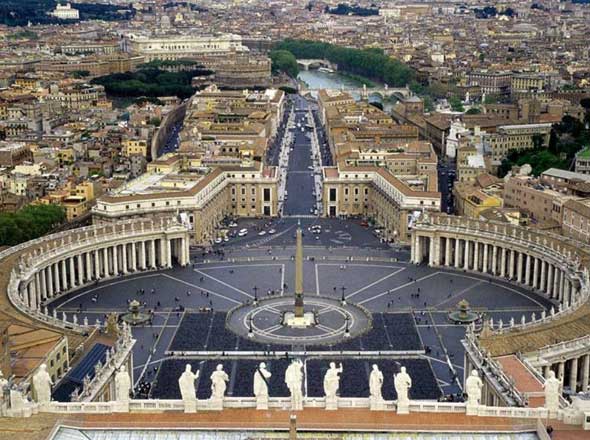 The square is in front of the homonymous basilica. The square is a beautiful example of baroque art and architecture and it is visited each year by millions of Christian pilgrims from all parts of the world.
The square is in front of the homonymous basilica. The square is a beautiful example of baroque art and architecture and it is visited each year by millions of Christian pilgrims from all parts of the world.
St. Peter's Square, with the Basilica, have always been considered the heart of Christianity and the Catholic Church, also the colonnade (the great work of the famous Bernini) remember two big arms that hug the faithful.
According to the thought of Bernini, St. Peter's Square had become a space for the faithful who were to receive the blessing "urbi et orbi" and therefore the Loggia of Benediction should be placed so that everyone could see it.
The Square is also the place then deputy seasonal liturgical celebrations and especially on Sundays at noon with the Angelus Domini, in which the Pope appears from the windows of his office and gives the blessing to the crowd that has gathered to hear him.
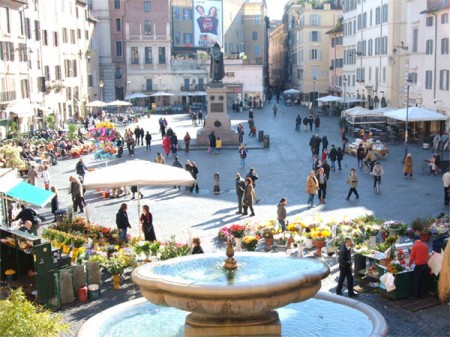 The square is one of the most famous and appealing place in Rome. The popular outdoor market, noisy and colorful, it’s very busy all day due to bar and restaurants for tourists and local. It’s the only square in Rome without churches. The statue of Giordano Bruno indicates its historical significance. The philosofer,indeed,was burned alive in February 1600 at the point were the statue has been erected, after being convicted of the Inquisition, the prevailing theory takes the name after Flora, a concubine of the emperor Pompeus or after via Florina who linked Largo Argentina with Campo dei Fiori. Other theories refer to the time when the square was covered in flowers and grass. The nightlife in Campo de’ Fiori is very active, as the square is one of the most popular meeting places in Rome.
The square is one of the most famous and appealing place in Rome. The popular outdoor market, noisy and colorful, it’s very busy all day due to bar and restaurants for tourists and local. It’s the only square in Rome without churches. The statue of Giordano Bruno indicates its historical significance. The philosofer,indeed,was burned alive in February 1600 at the point were the statue has been erected, after being convicted of the Inquisition, the prevailing theory takes the name after Flora, a concubine of the emperor Pompeus or after via Florina who linked Largo Argentina with Campo dei Fiori. Other theories refer to the time when the square was covered in flowers and grass. The nightlife in Campo de’ Fiori is very active, as the square is one of the most popular meeting places in Rome.
Piscinula Square (Piazza in Piscinula)
It’s name derives from the ancient presence of a watering -place with baths and swimming pools, "piscinula", is the name which it still has.
The medieval place is suggestive, with the small palace of Mattei family (philo-papal family), the arcades with the medieval column, and the loggia.
In the place we find the Church of San Benedetto in Piscinula, of the XI century, and its bell tower, built on the ruins of the Domus Aniciorum, villa of a very noble and ancient Roman family, the Anicii family, to whom Saint Benedict of Norcia belonged too. It was the house where the saint was during his stay in Rome, as it was proved into the church.
At street number 19, the palace Nuñez Leslie, half of the XVI century, inhabited by the beautiful artist, intellectual, and paramour, Tullia d'Aragona.
In 1870 it became the “locanda in piscinula”, and the Roman people renamed it “la locanda della Sciacquetta”, a term used for the servants and sluts, maybe, because it was their use of the palace of that time.
On the place there are also “a little virgin ” and a table of marble portraying four fishes.
Clock's Square (Piazza dell'Orologio)
The name of the place derives from the clock, placed on the tower of the Monastery of the Filippini. This tower, built from Borromini in 1648, is surmounted in a castle -way, with a structure of iron, which supports the bells, on the sides two other little structures, with the heraldic stars of bronze with 24 points. Under the dial of the clock, placed into the façade, a beautiful mosaic, with the project by Pietro da Cortona portraying the "Madonna della Vallicella".
On the place, called in the past "Piazza dei Rigattieri" and "Piazza di Monte Giordano", is situated Bennicelli Palace, built on wish of Monsignor Virginio Spada, of the “Banco di S. Spirito”.
The works began in 1660 by the same Borromini, but, after the death of Virginio Spada, the ministers of the Bank decided that, the new location would be this building. It is called still today “Palazzo del Banco di S. Spirito”.
The palace which we can admire today, with its elegant portal, it is the result of the renovation works at the end of the XIX century by the architect Gaetano Koch, who transformed fully the work on wish of the new owners, the Earls Bennicelli.
In this house the most famous of the Bennicelli was born and lived, Hadrian, known as "Conte Tacchia", because his family, dealt wood, and "tacchia," in Rome, means piece of wood.
And in roman language we say "ogni botta 'na tacchia", that means that according to the Earl, what one does, leaves his mark. The "Conte Tacchia" was famous for his way of living, for his unconventional behaviour together with a very elegant way of dressing, his fame in Rom has never over.
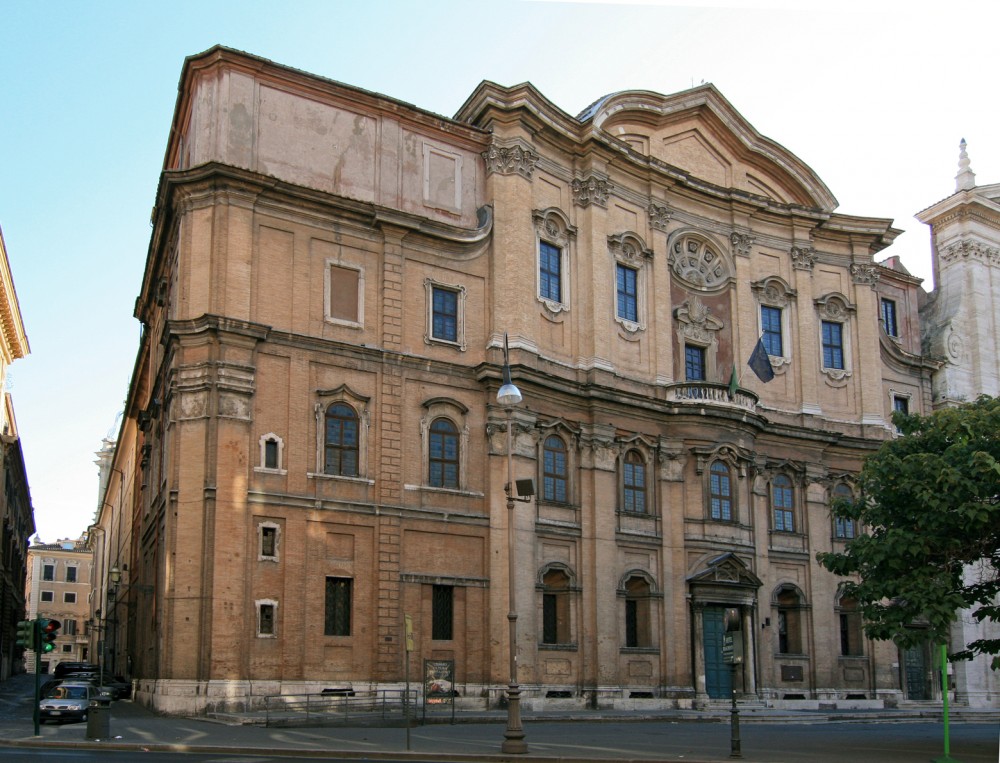 At the intersectionof the place with via del Governo Vecchio, you can admire a great work of the late 17 or 18 century by a follower of Borromini, a precious fresco with "Madonna with benedictory Child".
At the intersectionof the place with via del Governo Vecchio, you can admire a great work of the late 17 or 18 century by a follower of Borromini, a precious fresco with "Madonna with benedictory Child".
Complex Borromini, Filipinos oratory: The building of the Palace, started in 1575 and lasted about a century. Among the architects that worked over the project during the years, Francesco Borromini made the most significant parts of the complex: the façade, the library ant the clocktower. A wing of the building is occupied by Fathers Filipinos, while the rest of the Palace is the site of various cultural institutions such as the Institute of Historical Italian Middle Age, the Capitol Historical Archive, and the Vallicelliana Library, designed by Borromini.
The place wasn’t archaeologically very important until 1926, when a town-planning scheme, approved in 1909 (urban renewal of the zone), highlights one of the most important archaeological complexes of Rome. The excavations highlight a wide paved place, on which there 4 temples. The area became immediately very important, such as, in 1927 the Governorship of Roma try to suspend the previous planning permission, to continue the archeological excavations. The area was inaugurated only in 1928 by Benito Mussolini, without any further modifications. The four republican temples, originally designed by the first 4 letters of the alphabet A,B,C,D (from north to south), were built from the beginning of the III century B.C. to the end of the II century B.C. Three were built on the original country plan of Campus Martius (the temples C, A and D), an external superelevated area. In the second half of the II century B.C. the 3 temples were integrated in a common area, with the creation of new tuff flooring , which raises almost 1 metres and half the level of the ground , in comparison to the original one. After this change, in the space among the temple C and the temple A, was built the temple B, which, as you see still today, lays on the tuff flooring and it must be chronologically later to it (referable to the end of the II century B.C.). The sacred area was finally created with the development of the fourth temple.
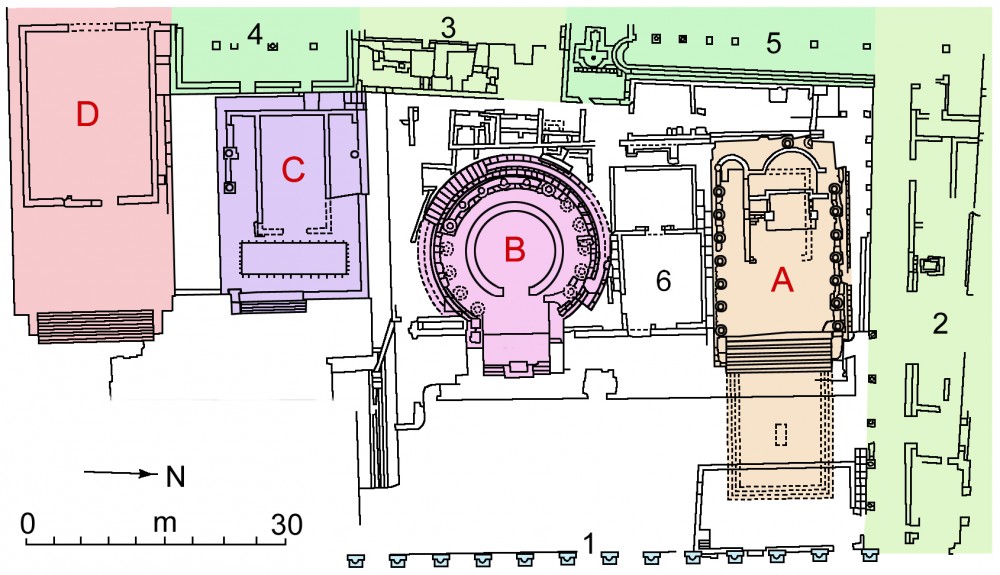
The 4 temples are:
A– Temple of Juturna (Iuturna ), Latin deity, related to water, with recovery powers. It was commissioned by Quintus Lutatius Catulus, after the victory of Romans against the Falerii in 241 B.C..
B– Temple of Fortuna (Fortuna Huiusce Diei), or deity of “ the fortune of this day”, commissioned by the consul Quintus Lutatius Catulus, to celebrate the victory against the Cimbri in 101 B.C.
C- Temple of Feronia (Feroniae), deity of fertility, nature and crops, and patroness of the freed slaves. She was imported from Sabina territory after its conquest by M. Curio Dentato in 290 B.C.
D- Temple of Lares Pemalini (Aedes Larum Permarinum), who protects sailors during navigation, it was vowed by Lucius Aemilius Regillus in 190 B.C.
This area is è sacred for the history of Rome too, there is the body of the great Julius Caesar, here murdered with 23 stabs by Brutus, Cassius and other followers (15 March 44 B.C.). A few years ago, a researcher, announced the discovery of the exact place where the murder of Caesar took place, just here, in “ the Curia of Pompeius”, the monumental centre of the architectonic complex, behind the temple C (but it lays today under the asphalt of the main street).The complex was commissioned by Gnaeus Pompeius in 55 B. C. It was a theater with a great rectangular colonnade, and the Curia, along one side of the colonnade. Suetonius and Plutarch (historians in that period) narrate that the exact place where Caesar was stabbed, was situated at the foot of Pompeius’ statue, which was built in the same Curia (the statue was discovered and today you can see it in Palazzo Spada). The right place was later protected with cement, by the will of Octavian Augustus. Today the area is one of the great colonies of cats of Rome.
Piazza Foro Traiano and Piazza della madonna di Loreto
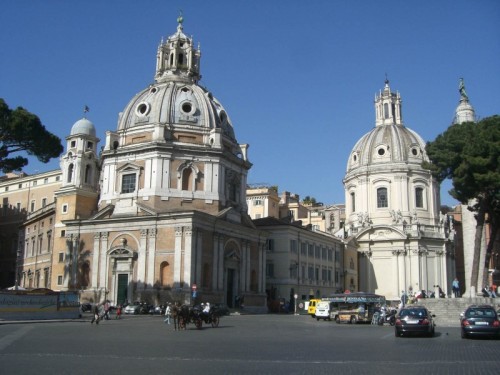 They are situated near place Venezia, in the direction of via dei fori imperiali. One of the most suggestive place of Rome, you must not miss it, you must photograph it! In front of it, there are two churches, Santissimo Nome di Maria (Holy Name of Mary) (1736), which was built by Antoine Dérizet and then (in 1743) Mauro Fontana and Agostino Masucci, decorated the inner side. Nearby there is Santa Maria di Loreto (Saint Mary of Loreto), commissioned by Pope Alexander VI to replace a previous little chapel. He entrusted to Antonio da Sangallo the Young the works (in 1507). The dome and the lantern (surnamed the "Cricket’s cage”) was realized later by Giacomo Del Duca (in 1582), disciple of Michelangelo. The church is built with bricks and travertine, and it is very beautiful for its dimensions and the effect produced. But you need to walk on the place to see another period, beginning from Trajan’s column (113 a..C ), about 30 metres high and a base 40 metres high, built to celebrate the victory against the Dacians. The military campaigns are engraved and counted all over the column, but if you observe it, you realize that you are in another period, in the background there is the coliseum.
They are situated near place Venezia, in the direction of via dei fori imperiali. One of the most suggestive place of Rome, you must not miss it, you must photograph it! In front of it, there are two churches, Santissimo Nome di Maria (Holy Name of Mary) (1736), which was built by Antoine Dérizet and then (in 1743) Mauro Fontana and Agostino Masucci, decorated the inner side. Nearby there is Santa Maria di Loreto (Saint Mary of Loreto), commissioned by Pope Alexander VI to replace a previous little chapel. He entrusted to Antonio da Sangallo the Young the works (in 1507). The dome and the lantern (surnamed the "Cricket’s cage”) was realized later by Giacomo Del Duca (in 1582), disciple of Michelangelo. The church is built with bricks and travertine, and it is very beautiful for its dimensions and the effect produced. But you need to walk on the place to see another period, beginning from Trajan’s column (113 a..C ), about 30 metres high and a base 40 metres high, built to celebrate the victory against the Dacians. The military campaigns are engraved and counted all over the column, but if you observe it, you realize that you are in another period, in the background there is the coliseum.
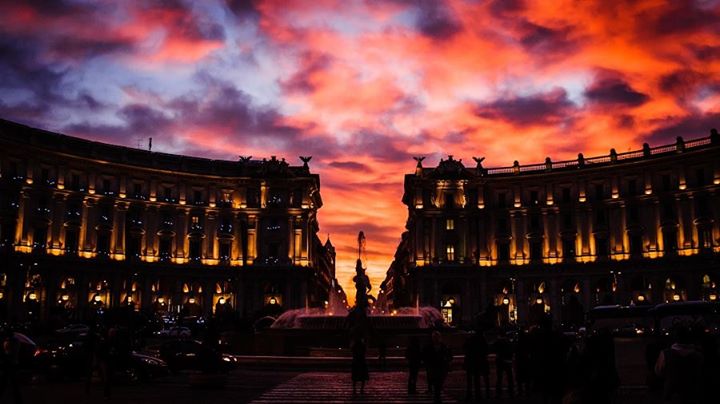 This place, that until 1960 was called piazza Esedra, is one of the most nocturnal suggestive places of Rome, for its lights and for its per its architectonic beauty. It is surrounded by a beautiful semicircular colonnade, developed by the porticos of the two main buildings ( in memory on the ancient buildings of Roma, by Gaetano Koch, between 1887 and 1898). The fountain in the middle of the place Fountain of the Naiads highlights more its charm. On the opposite side the Basilica di Santa Maria degli Angeli e dei Martiri by Michelangelo Buonarroti is the background.
This place, that until 1960 was called piazza Esedra, is one of the most nocturnal suggestive places of Rome, for its lights and for its per its architectonic beauty. It is surrounded by a beautiful semicircular colonnade, developed by the porticos of the two main buildings ( in memory on the ancient buildings of Roma, by Gaetano Koch, between 1887 and 1898). The fountain in the middle of the place Fountain of the Naiads highlights more its charm. On the opposite side the Basilica di Santa Maria degli Angeli e dei Martiri by Michelangelo Buonarroti is the background.
Fountain of the Naiades: In the past it was a circular pool with the borders of stones, and from which jets of water poured out. Pope Pius IX in 1870 had the idea of renewing the fountain to celebrate the conclusion of the works executed in the area, named“ Acqua Marcia”. At first he commissioned it to the architect Alessandro Guerrieri. The Pope was not satisfied with him , therefore the work was commissioned to Mario Rutelli, who completed it in 1901. It was a controversial work, especially during the period of the Rome of Popes (1800), because it was considered too much sexy, probably because of their 4 females figures of bronze, which represent 4 Nymphs (young girls); the Nymph of the Lakes, who holds a swan, the Nymph of the Rivers on a monster of the rivers, the Nymph of the underground waters on a dragon, and the Nymph of the Oceans riding a horse of the sea, all enriched with jets of water. It is one of the most beautiful fountains in Rome.
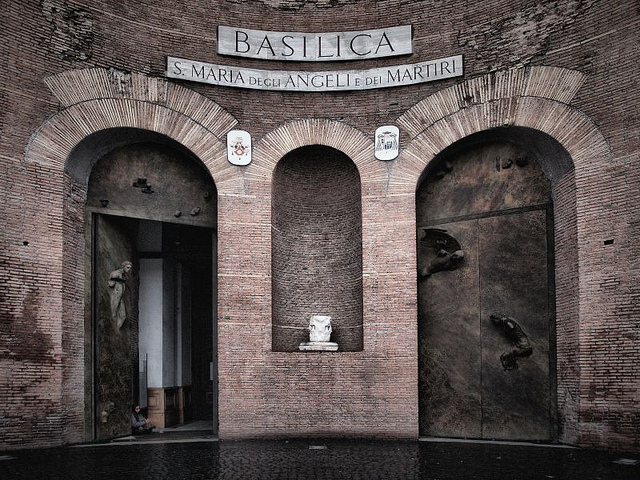 Basilica of Saint Mary of the Angels and the Martyrs: The original structure belonged to the Baths of Diocletian, but in 1561 pope Pius IV commissioned the project to the old Michelangelo (Bonarroti) who worked in that time in the Basilica of St. Peter. It was the last great architectonic project by Michelangelo, the genius, and showed it in this work too, with the integration of a sacred building to the baths, without changing the structure. Its façade is singular, it’s concave with bricks (because derived from an area of the baths), and Michelangelo converted it in the entrance of the basilica. At the entrance is an round area with two square cavities (exedra), which corresponded to the ancient ” tepidarium” (the baths of warm water ). To obtain the plan from a Greek cross, Michelangelo, shows all his talent, he uses the main room of the baths, giving an ancient and solemn structure, thanks to the eight columns of red granite and to its high vaults too. On the floor of the cross, is the Meridian or line Clementine commissioned in 1702 by pope Clement XI. It is a great line of bronze enclosed in a band of marble, about 45 meters long. On the right of the line were represented the zodiac signs with inlays, while on the left the constellations, and finally the image of the sun which penetrates in the middle of the coat of arms of Clement XI.
Basilica of Saint Mary of the Angels and the Martyrs: The original structure belonged to the Baths of Diocletian, but in 1561 pope Pius IV commissioned the project to the old Michelangelo (Bonarroti) who worked in that time in the Basilica of St. Peter. It was the last great architectonic project by Michelangelo, the genius, and showed it in this work too, with the integration of a sacred building to the baths, without changing the structure. Its façade is singular, it’s concave with bricks (because derived from an area of the baths), and Michelangelo converted it in the entrance of the basilica. At the entrance is an round area with two square cavities (exedra), which corresponded to the ancient ” tepidarium” (the baths of warm water ). To obtain the plan from a Greek cross, Michelangelo, shows all his talent, he uses the main room of the baths, giving an ancient and solemn structure, thanks to the eight columns of red granite and to its high vaults too. On the floor of the cross, is the Meridian or line Clementine commissioned in 1702 by pope Clement XI. It is a great line of bronze enclosed in a band of marble, about 45 meters long. On the right of the line were represented the zodiac signs with inlays, while on the left the constellations, and finally the image of the sun which penetrates in the middle of the coat of arms of Clement XI.
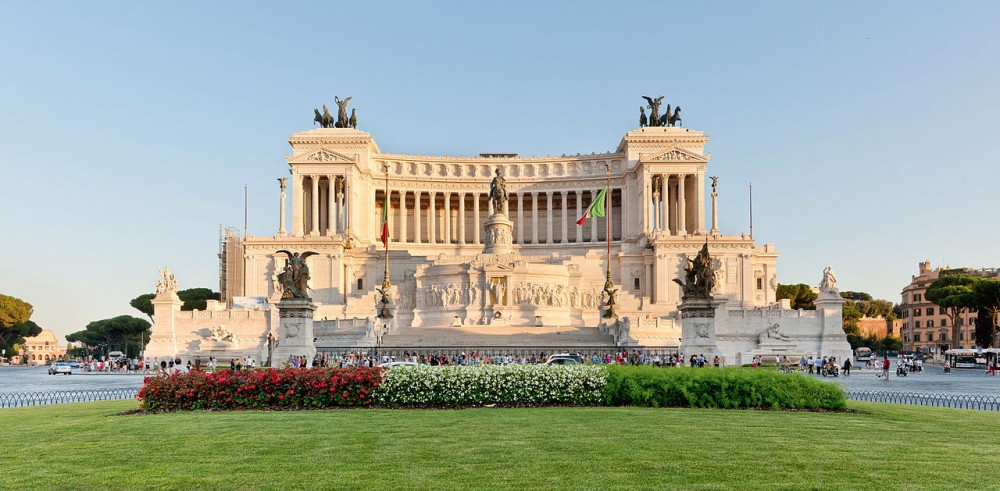 It is situated at the foot of the Capitoline Hill, in which 5 of the most important streets of Rome intersect. The current look of the place is the result of the works of demolition and reconstruction done between the end of the 19 century and the beginning of the 20 for the erection of Vittoriano, projected by the same architect of the building, Giuseppe Sacconi. Sacconi designed the Palace of the General Insurance (situated on the place) too, approved in 1902 and inaugurated only in 1906. Its face draws on the main lines of the palace in front of it, Palazzo Venezia. If we see this last building from the place, the first curiousness which stimulates the mind, is to observe the balcony of Mussolini, where he delivered his speeches to the people, when Palazzo Venezia was the seat of Government. At the bottom of the place (opposite side of the Vittorino) Palazzo Bonaparte, where Letizia Ramolino, Napoleon’s mother lived from 1818 until her death.
It is situated at the foot of the Capitoline Hill, in which 5 of the most important streets of Rome intersect. The current look of the place is the result of the works of demolition and reconstruction done between the end of the 19 century and the beginning of the 20 for the erection of Vittoriano, projected by the same architect of the building, Giuseppe Sacconi. Sacconi designed the Palace of the General Insurance (situated on the place) too, approved in 1902 and inaugurated only in 1906. Its face draws on the main lines of the palace in front of it, Palazzo Venezia. If we see this last building from the place, the first curiousness which stimulates the mind, is to observe the balcony of Mussolini, where he delivered his speeches to the people, when Palazzo Venezia was the seat of Government. At the bottom of the place (opposite side of the Vittorino) Palazzo Bonaparte, where Letizia Ramolino, Napoleon’s mother lived from 1818 until her death.
